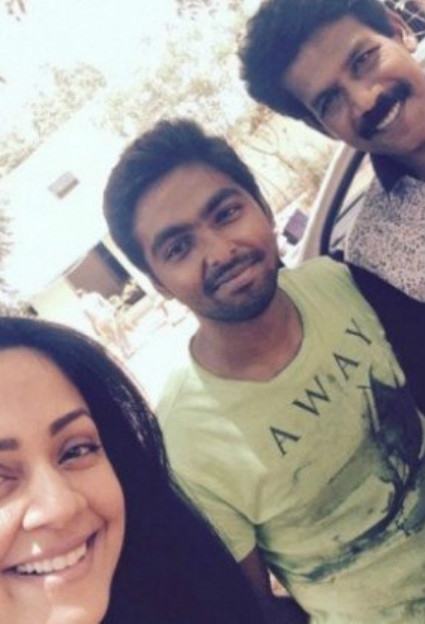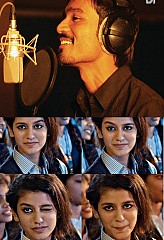

“The path of the righteous man is beset on all sides by the inequities of the selfish and the tyranny of evil men… And I will strike down upon thee with great vengeance and furious anger those who attempt to poison and destroy my brothers... And you will know my name is the Lord when I lay my vengeance upon thee.”
Jules, one of the protagonists of Quentin Tarantino’s Pulp Fiction, played by Samuel L Jackson, recites the above chant whenever he brutally kills someone. The almost dialogue-less climactic sequence of Bala’s Pithamagan is a visual embodiment of the above pseudo-chant. The sequence is notorious for its gore and shocking element, in which the protagonist, Chithan, played by Vikram, kills the villain by beating him to a pulp and gnawing at the pulsating blood vessel in his neck.
It’s quite unlikely that you overlay the iconic scene from Pulp Fiction with the unforgettable climax from Pithamagan when you start writing about Bala’s latest Tamil flick, Naachiyar. But, for any filmmaker who is an auteur in his own rights, it’s inevitable to revisit his earlier works
and its parallels in order to locate where he has reached now. Bala’s movies are highly regarded by some and censured by some, interestingly, for almost the same reasons.
Like Tarantino, Bala’s movies are made on a fundamental disgust of a loveless society, its moral codes and decayed institutions. While Tarantino and his characters choose to laugh at the sick society and go on their own way, Bala and his characters take the dangerous step ahead and end up destroying themselves. This leads to another key question. What makes Bala one of the most uncanny filmmakers operating in our times? And, what is his cinematic reality?
At the end of his 1999 debut feature, Sethu, the protagonist goes mad. A mother prepares a poisoned meal with her own hands, and feeds it to her son and kills him in the 2011 movie, Nandhaa. In the 2016 flick, Thaara Thappattai, the belly of the pregnant female protagonist is cut open to pull the baby out, and leaving her to die. There are similar horrendous scenes and bloodbaths in his other movies like Naan Kadavul, Avan Ivan and Paradesi too.
Two things that strick our mind while revisiting these movies are Bala’s lack of finesse in treatment and the nihilistic and misanthropic undertones of his characters. Did they really represent Bala’s world view, and if so, why does he hate the world so much? Bala’s characters
always find themselves at odds with luck, moral codes of the society and even with their own self, which yearns for tenderness and love. Often, they are victims dumped into the void created by the absence of empathy in the society.
This can be considered as a postmodern existential crisis faced by filmmakers worldwide. Tarantino dealt with it by using irony to create striking moments of black comedy. On the other hand, Bala plunged into the depths of disaffected nihilism and surfaced with cut-throat tragedies, in which none of his protagonists “lived happily ever after.” Bala’s choice of a jarring visual narrative instead of cinematic finesse bestows the explosiveness in output for his movies.
There are very few filmmakers in Indian cinema who took such a career path, and Anurag Kashyap is one among them. Traces of a similar nihilism can be found out in his movies like Gulaal and Raman Raghav 2.0. But, Bala dared to embark further on the path of gore, revenge, and disturbing imageries, and unlike Tarantino and Anurag Kashyap, he never restricts or protects his characters from the inevitable face-off with the hostile society and mortal fate.
Coming back to Naachiyar, most of the reviews about the movie are either perplexed or happy about the conspicuously trimmed down proportion of gore and gruesome elements. The movie is also hailed for its surprisingly happy ending and stunning performances, while the staunch supporters of Bala point out the lack of multilayered complexity in characterisation. Setting aside the commercial parameters, it is a curious sign of a filmmaker with a signature style making a pivotal turn.
Taking into consideration the commercial parameters, it’s a bold move to brush the critics off his heels by innovating a less intense, trimmed down, emotionally sublime style. It can also be read as a reaction to the hours of physical and emotional real-life violence we are exposed to on a daily basis.
“If you ask me how I feel about violence in real-life, well, I have a lot of feelings about it. It's one of the worst aspects of America. In movies, violence is cool. I like it,” said Tarantino at a press conference, in Newsday, 1994; if graphic violence is one of the worst and ubiquitous aspects of our society, then Bala too might be fed up with using it in movies anymore, and hence, we have Naachiyar.
Behindwoods is not responsible for the views of columnists.

OTHER LATEST BEHINDWOODS COLUMNS
RAGESH DIPU'S OTHER COLUMNS
- From Kolaveri to Priya Prakash Varrier, And How #hashtags Grow Bigger Than the Movies!
- From Mahesh to the Fakir: The Extraordinary Journey of Dhanush
- The attacks and assaults on actresses, or should we say, women
- A question at the time of the theatre shutdown: Why are we going to the movies?
- From Anbe Sivam to Velaikkaran - How Tamil Cinema dealt with consumerism
- How Malayalam and Tamil cinemas exchanged actors



